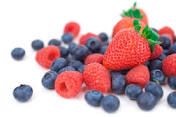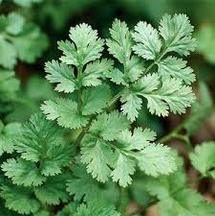|
Ozark Green Thumb BCMG Monthly e-Newsletter |
|
|
|
MAY GARDEN CHECKLIST
The following is a garden checklist:
County Extension Agent- Telephone: 425-2335 For more information on gardening, contact the University of Arkansas Division of Agriculture Baxter County Extension office at 425-2335.
0 Comments
 A delicious cake like muffin, perfect when fresh fruit is ripe like right now. Oven: 375 degrees F. Bake: 25-30 minutes Yields: 12 muffins Ingredients: 6 T. Butter (86 g) 3/4 c. Sugar (150 g) 2 Large Eggs 2 c. + 2 T. All Purpose Flour (243 g) 1 T. Baking powder 1/2 tsp. Salt 1/2 c. Milk (122 g) 2 tsp. Vanilla extract 1/4 tsp. Almond extract 2 c. Mixed Berries: Blueberries Strawberries Raspberries (fresh or frozen thawed and drained) slice larger berries Topping 1 T. Sugar 1/2 tsp. Cinnamon Directions:
 How to Grow Cilantro Cilantro needs full sun or light shade in southern zones since it bolts quickly in hot weather. It grows best in a well-drained, moist soil. Cilantro plants should be spaced about 6 to 8 inches apart. To harvest fresh cilantro all season, make successive sowings every 2 to 3 weeks starting in late spring. From the time of sowing seed, cilantro leaves can begin to be harvested in about 3 to 4 weeks. Cilantro seeds can be harvested in about 45 days. Coriander / Cilantro Coriandrum sativum Interesting Facts
Flowering Coriander for Aphid Control In the Salinas Valley of California, aphids have been one of the worst pests in the lettuce fields. The USDA Cooperative Extension Service has been investigating organic methods for aphid control, and experimented with coriander plants and Alyssum plants; when intercropped with the lettuce and allowed to flower, they attract beneficial insects such as hoverflies, the larvae of which eat up to 150 aphids per day before they mature into flying adults. The Herb Society of America www.herbsociety.org
Wikipedia  Tree Peony Latin: Paeonia suffruticosa Tree peonies form flowers as much as 8 inches across when they bloom in late April.As Americans, we tend to take an egocentric view of the world, often assuming that other places and cultures have little to offer. Because really old and rich civilizations such as China baffle and bewilder us, most Americans dismiss them as backwards, if they think of them at all. But, for gardeners we must embrace China for she has provided many of our most cherished garden flowers, including the stunningly beautiful tree peony. Paeonia suffruticosa, the tree peony, is a deciduous woody shrub growing to 6 feet tall and wide. It has stout, sparsely branched stems and coarse, compound leaves with nine leaflets. The leaves are bright red when they emerge in early spring. As the season advances, the flower buds begin to swell, reaching the size of a small apple before issuing forth in late April with a flower the size of a salad plate. Double forms are most common with the blossoms in delicate pastel shades of red, pink, white and yellow. The beauty of the flower is unsurpassed, making it easy to understand why the Chinese treasure tree peonies as Western culture does the rose. Tree peonies have been mentioned in Chinese literature since the 4th century BC and have been an important garden plant since at least the Tang Dynasty (618-907). Chinese scholars look to this dynasty as a long, stable reign of rulers who promoted learning and the arts, including gardening. This progressive age saw the elevation of women in Chinese culture, in large measure due to the efforts of Wu Zetian (625-705). Empress Wu was born into a noble family and, as a young girl became one of the ruler’s concubines. Through a series of deft maneuvers and palace intrigues, she had herself named Empress when her own son resigned the throne in 690, breaking with the long held Confucian teaching that only men could become rulers. Empress Wu’s connection to the tree peony is probably pivotal in the development of the flower, for she is said to have banned it from her gardens and palaces because it failed to bloom as precociously as she felt it should. This banishment was the catalyst for breeders to develop the free-flowering forms that are found in gardens today. When European merchants and plant explorers introduced the plant to Europe, they simply purchased them from retail sources that had been growing and selling the plant for over 1,000 years. Tree peonies can be grown in all parts of Arkansas but are less common in gardens than their herbaceous cousins. Their rarity in cultivation is because they’re difficult to propagate. The Chinese learned early on that they could be grafted onto the rootstock of an herbaceous peon, a straightforward but not necessarily easy grafting procedure. Many of the 350 named cultivars listed are old Chinese selections, simply given new names when they were introduced into Europe. Tree peonies do best in a fertile, well drained garden soil. They will grow in full sun or light shade and are easy to grow if well sited. They should be watered during dry periods and fertilized with a topdressing of compost each spring. The flowers are susceptible to wind and weather during the time they are open, so afternoon shade and wind protection helps preserve the length of their all too short bloom display. By: Gerald Klingaman, retired Extension Horticulturist - Ornamentals Extension News - April 1, 2005  This is an easy healthy dinner, you can put together in no time. Ingredients:
Directions:
Nutritional Information: Serves 4; 3 ounces fish and 1/3 cup sauce per serving, Calories: 151
Total Fat: 5.5 g Cholesterol: 57 mg. Sodium: 329 mg Carbohydrates: 3 gm. Protein: 23 grams Source: American Heart Association 2007 |
Archives
April 2022
|
|
